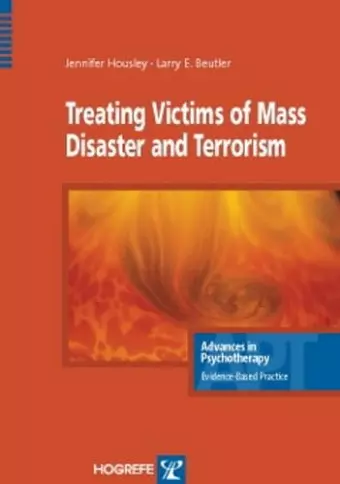Treating Victims of Mass Disaster and Terrorism
Jennifer Housley author Larry E Beutler author Josef I Ruzek author
Format:Paperback
Publisher:Hogrefe Publishing
Published:1st Oct '06
Should be back in stock very soon

The mental health effects of disasters and terror events can be severe, and are most effectively characterized as differing stress reactions with psychological consequences. Empirical studies show that addressing these consequences requires a staged approach to care. This volume, written by leading experts, provides professionals with practical, evidence-based guidance on diagnosis and treatment following disaster and terrorist events - and does so in a uniquely "reader-friendly" manner. It is both a compact "how-to" reference, for use by professional clinicians, as well as an ideal educational resource for students and professionals and for practice-oriented continuing education. The unique feature of the book is that it outlines a staged approach for post-disaster mental health care, based on empirically supported principles of treatments that work. Practical and reader-friendly, it is a compact and easy-to-follow guide covering all aspects that are relevant in real-life.
Recent years have demonstrated the uncertainty of the world and theneed to be prepared for disasters. Whether natural disasters hurricanes, tornadoes, or earthquakes) or man-made disasters terrorist attacks or conflict between groups of people), these events result in many people being subjected to mass trauma. The survivors of these occurrences include not only those who directly experience the event but also the first responders and subsequent relief workers. As a result, there is a growing concern among mental health professionals resulting in a desire to determine best practices for treating the survivors of mass trauma.Treating Victims of Mass Disaster and Terrorism makes a significantcontribution to the treatment of survivors of disasters and terrorism and contribution to the treatment of survivors of disasters and terrorism and will likely become a valued resource for those interested in disaster mental health.The contributions of this work include a great deal of informationin a short amount of space for those who want a review or overview ofdiagnosis. There is also a summary of risk factors that is veryinformative and easy to follow. The integration of assessment,evaluation, and treatment into the three stages of postdisaster care is useful in the conceptualization of the experience from the individual's perspective so that the needs of a client can be better anticipated. Much of the information presented is practical, although Section 4.6, Additional Tools for Responders, is likely to be the most useful for those mental health professionals working on the front lines. The many tables and lists provide large amounts of information in a succinct and effective manner. It would be even more helpful to somewhere have a list of the tables and their page numbers included for easier access. Overall, Sections 3 and 4 provide a nice discussion of treatment methods research, the pros and cons of research in the field, and good explanations of the development of the empirically derived guiding principles. These guiding principles are principles of change rather than of a particular therapeutic mode and are used to guide treatment through the threes stages of postdisaster care.There are also limitations. Although the volume is less than 100pages, it is difficult to read and does not flow easily. There areparagraphs that seem repetitive and in places the text appears to be cut and pasted from previous sections with only a word or two edited.Additionally, there seems to be more use of research jargon (quasiexperimental design, variables, etc.) than average therapists want in a how-to-do-treatment guide. This is especially true for one that they would take with them when deployed to work in a disaster area, as suggested by the Housley and Beutler in their self-care section. There is also a seemingly minor discrepancy with the use of terms that may have implications for the reader's subjective interpretation. In the title, the term victim is used, but in the text victim, patient victim, patient, and survivor are all used in reference to the person receiving treatment (term from the title). The individual administering the treatment is called the clinician, provider, and worker. Although these discrepancies may be nothing more than the result of the book's having two authors or of sections being written at different times, the writer's choice of words will influence how the reader perceives those who have been affected by disaster or terrorism. Survivor indicates that a normal person has lived through some bad experience. The term victim indicates someone who is helpless because he or she has experienced some misfortune. Patient is usually reserved for someone receiving medical treatment. In the opening two paragraphs, it is proposed that treatment is defined by the event, not by pathology, and that people areresilient and do not need a diagnosis of a mental disorder. I wouldsuggest, therefore, that survivor is the term most consistent with howHousley and Beutler want their readers to think about individualsreceiving treatment. Other areas that could improve the usefulness of this volume would be more information about the interaction of the severity of the trauma experienced and the symptoms manifested (Dahl, Mutapcic, & Schei, 1998; Moreno & Gibbons, 2002). It would also be helpful to provide more discussion related to the stages of recovery experienced by the survivor (honeymoon stage), long-lasting events such as the aftermath of Katrina, ongoing war as in Iraq, or continued threats of attack such as the experience of Israelis (Somer, Sever, Ruvio, & Soref, 2007). Additional examples of the tools, perhaps short vignettes, would be helpful for mental health providers as well.Finally, although the intended audience is therapists who areeither current or potential disaster workers wanting information on best practices, this may not be the group that would find the volume most useful. Program planners, agency administrators, managers of relief efforts, or even trauma and disaster researchers may find this book more useful.Reviewed by Mary Dugan in PsycCRITIQUESSeptember 12, 2007, Vol. 52, Release 37,(c) 2007, American Psychological Association
ISBN: 9780889373211
Dimensions: unknown
Weight: unknown
86 pages